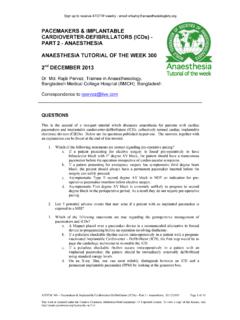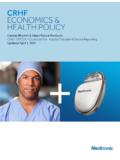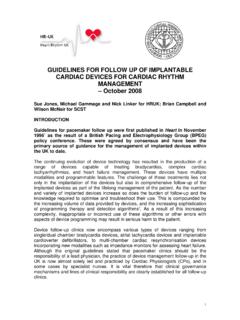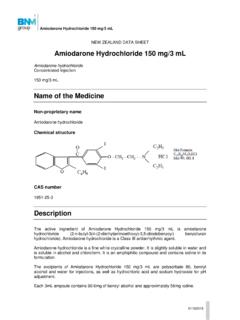Transcription of The management of surgical complications of pacemaker …
1 66 The management of surgical complications ofpacemaker and implantable cardioverter -defibrillatorsStephen Pavia, MD, and Bruce Wilkoff, MDThe rate of implantation of pacemakers and implantablecardioverter-defibrillators (ICDs) is ever-increasing. The relativeease of device implantation utilizing a relatively simple, expedi-tious, percutaneous approach, without the requirement forgeneral anesthesia or long recuperation times, has fueledenthusiasm for implantation. However, the complication risk isever-present and forms the subject of this pragmatic review,which is limited to the management of only the surgical compli-cations of device implantation.
2 The management of surgicalcomplications related to the implantation of pacemakers andICDs should include (1) awareness of potential complications ,(2) a meticulous approach to the implantation procedure toavoid complications , (3) approach to diagnosis and (4)specific therapy. With a clear understanding of the acceptedimplant indications and potential complications , and a meticu-lous approach to the implant and post implant follow up, theincidence of complications can be minimized. Curr Opin Cardiol2000, 16:66 71 2001 Lippincott Williams & Wilkins, Cleveland Clinic Foundation, Cleveland, Ohio, to Bruce Wilkoff, MD, Director of Cardiac Pacing andTachyarrhythmia Devices, The Cleveland Clinic Foundation, 9500 EuclidAvenue, Cleveland, OH 44195, USA.
3 E-mail: Opinion in Cardiology2001, 16:66 71 AbbreviationsICDimplantable cardioverter -defibrillatorsSVCS superior venacava syndromeISSN 0268 4705 2001 Lippincott Williams & Wilkins, rate of implantation of pacemakers and implantablecardioverter-defibrillators (ICDs) is increase parallels the potential for more wide-spread indications pending the results of ongoing trialsof pacing in heart failure and sudden death relative ease of device implantation utilizing a rela-tively simple, expeditious, percutaneous approach,without the requirement for general anesthesia or longrecuperation times, has fueled enthusiasm for implanta-tion.
4 However, the complication risk is ever-present andforms the subject of this may be surgical /hardware, program-ming/software, or normal device function specific complications include failure to pace(Table 1), failure to sense (Table 2), pulse generatorfailure (Table 3), pacemaker syndrome and pacemakermediated tachycardia. complications specific to the ICDinclude ineffective therapy, failure to deliver therapy,multiple shocks (both appropriate and inappropriate), anddevice proarrhythmia. Both pacemakers and ICDs maybe subject to crosstalk, electromagnetic interference, andpatient psychological issues.
5 This review, however, limitsdiscussion to surgical complications . Managing surgicalcomplications related to the implantation of pacemakersand ICDs should include (1) awareness of potentialcomplications, (2) a meticulous approach to the implanta-tion procedure to avoid complications , (3) approach todiagnosis, and (4) specific recent publication of device complication rates showedan acute pacemaker implant complication rate of 4 to 5%[5]. implantable cardioverter -defibrillators lead complica-tions occur in 10 to 16% of patients [10], and even higherwhen programming and potential psychological complica-tion data are considered.
6 The nonthoracotomy implanttechnique portends a lower complication rate than thenow superceded open thoracotomy, epicardial patchapproach. Hardware and implantation related complica-tions often require further surgical intervention. The inci-dence of device related implant complications has beenshown to be implanter-experience related [3,5] andsimilar with single or dual chamber implantation [4].An exhaustive list of potential complications is outlinedin Table 4. Each surgical complicationand specificmanagement strategy will be dealt with in will be divided into venous access related,lead related, and pocket related.
7 Infection is anextremely important complication that is discussedseparately. Unless specifically stated otherwise, discus-sion incorporates complications applicable to both pace-maker and ICD access related complicationsPneumothoraxThis complication occurs uncommonly and is directlyrelated to operator experience, the difficulty of thesubclavian puncture, and is almost eliminated using thecephalic cut-down technique. However, these traditionalcomparisons may become obsolete as the axillary veincannulation technique [16] threatens to eliminate thiscontroversy.
8 Often the pneumothorax is asymptomaticand noted on routine follow-up plain chest complication results from trauma to the greatvessels rather than the lung. The risk can be minimizedby direct inward and outward passes of the punctureneedle rather than a side-to-side, potentially lacerat-ing movement. If an arterial puncture is performed,recognition, withdrawal, and digital pressure are impor-tant. Never cannulate the artery with the introducer, asituation that should indicate vascular surgical this situation by always checking the fluoroscopicpath of the guidewire into the inferior venacava beforeintroducer embolismDeep inspiration at the time of central venous access maycause significant air to be drawn into the venous systemdue to the physiological negative pressure developed.
9 Itcan be prevented through operator care and using intro-ducers with hemostatic valves. The diagnosis is obviousbecause it is heralded by a hissing sound as the air issucked in and with the fluoroscopic confirmation thatfollows. Patients are surprisingly tolerant of this , respiratory distress, hypotension, and arterialoxygen desaturation may occur depending on the size ofthe embolus and 100% oxygen should be administeredalong with ionotropic support in some cases [7]. Aspirationof the embolus from the right heart has also been success-ful.
10 However, usually no therapy is required, as the air isfiltered and consequently absorbed in the complicationsPerforationThe lead may perforate any of the great veins, the atria,or ventricle during the implant procedure. This compli-cation almost always occurs in the cardiac chamber onlead manipulation or fixing a screw in lead, and conse-quently bleeds into the pericardial space. Perforationusually occurs without serious sequelae. However, amost devastating manifestation is cardiac tamponade,which requires prompt diagnosis and percutaneouspericardiocentesis, possibly followed by surgical inter-vention if the bleeding persists.







